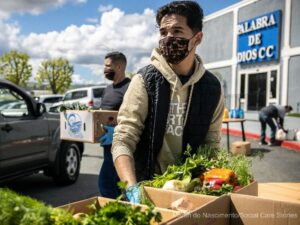Office of Public Affairs
For Immediate Release: November 4, 2021
Release #2021-07
Media Contact: Office of Public Affairs, Lance Klug
916-341-6293 | lance.klug@calrecycle.ca.gov
Local surplus food recovery projects already saved 142 million meals


Surplus food donations (left) and redistribution (right) provide 142 million meals for hungry Californians
and reduce climate pollution equal to taking 34,862 cars off the road for a year.
SACRAMENTO– To help feed 1 in 5 Californians without enough to eat and cut climate emissions from the over 1.8 billion still fresh, surplus meals landfilled in the state every year, California is funding food recovery projects with $2.8 million in new grants. This new program is part of the state’s latest $270 million investment in the climate fight and California’s transition to a renewable economy. “State food recovery investments have already provided 142 million meals to Californians in need since 2018,” California Department of Resources Recycling and Recovery (CalRecycle) Director Rachel Machi Wagoner said. “Local food recovery projects provide an incredible opportunity to feed hungry members of our communities instead of wasting unsold food by dumping it in landfills to emit climate super pollutants.”
New Surplus Food Recovery Funding
Local governments, nonprofits, state agencies, schools/universities and tribal governments have until Dec. 16, 2021, to submit their applications for up to $250,000 in Edible Food Recovery Grant Program funding for projects that:
- Rescue and redistribute surplus food instead of sending it to landfills, or
- Prevent food waste that would otherwise be destined for landfills
Food, yard and other organic waste rotting in landfills emits 20 percent of California’s methane, making it a top source of climate super pollutants in the state. Methane is 84 times more effective at trapping heat in the atmosphere than carbon dioxide.
Local projects rescued 142 million meals for hungry Californians
California’s latest $2.8 million investment in local surplus food recovery projects build on the success of previous CalRecycle grants that, since 2018, resulted in:
- $24 million to 80 local government, nonprofit, school and university projects.
- 142 million surplus, still fresh meals rescued for Californians in need.
- Reduced climate emissions equal to taking 34,862 cars off the road for a year.
- 394 local jobs to collect, store, transport and redistribute surplus food.
Circular economy investments feed Californians, cut trash and climate pollution
CalRecycle’s new Edible Food Recovery Grant Program is part of Governor Gavin Newsom’s California Comeback Plan, which features a $15 billion climate package–the largest such investment in state history. It includes $270 million to support a circular economy that advances renewable product manufacturing and reduces climate super pollutants, like landfill methane emissions.
Key circular economy investments over the next two years include:
- $5 million to expand edible food recovery projects to reduce the estimated 1.8 billion edible meals landfilled in California each year.
- $5 million to expand Community Composting programs that increase air-cleansing, green spaces and recycle food waste in disadvantaged communities.
- $20 million to upgrade wastewater treatment plants that turn food waste into clean energy.
- $75 million to spur innovation, raise demand for recyclables and attract green industry to California with CalRecycle’s new Office of Innovation in Recycling and Remanufacturing.
- $165 million to support food and yard waste recycling infrastructure and local implementation costs for SB 1383.
Biggest Change to Trash in 30 Years Takes Effect Jan. 1, 2022
SB 1383 (Lara, Chapter 395, Statutes of 2016) builds upon California’s commitment to reduce pollution and greenhouse gas emissions statewide, improve human health, and create green jobs that support resilient local economies.
Starting Jan. 1, 2022:
- California cities and counties must provide organics recycling collection to all residents and businesses.
- Businesses and large food generators must donate unsold food to distribute to Californians in need.
For more information contact, the Office of Public Affairs, opa@calrecycle.ca.gov

Home Page | News Releases | Public Meetings | Event Calendar | Videos | Publications | Organics | Bottles and Cans
CalRecycle's mission is to protect California's environment and climate for the health and prosperity of future generations through the reduction, reuse and recycling of California resources, environmental education, disaster recovery, and the transition from a disposable to a fully circular economy.
